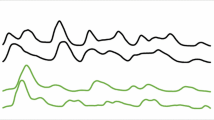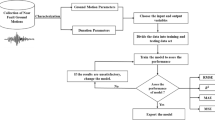Abstract
Strong-motion data processing is necessary to evaluate reliable ground-motion for standard or specific applications. We describe a processing web-service, fully integrated with the engineering strong motion database (ESM), a daily-updated strong-motion archive that contains more than 50,000 waveforms of events with magnitude ≥ 4.0, mainly recorded in the Pan-European region. A user-friendly web front-end allows the interactive use of a “robust” procedure (in the sense that it has been extensively tested), in order to select and process uncorrected waveforms from the ESM database, and derive several products: processed acceleration, velocity and displacement time series, as well as acceleration and displacement response spectra. The service is addressed to engineering seismologists, earthquake engineers, but also to students and professionals, if adequately trained.





Similar content being viewed by others
References
Akkar S, Bommer JJ (2006) Influence of long-period filter cut-off on elastic spectral displacements. Earthq Eng Struct Dyn 35:1145–1165
Beyreuther M, Barsch R, Krischer L, Megies T, Behr Y, Wassermann J (2010) ObsPy: a python toolbox for seismology. Seismol Res Lett 81(3):530–533. https://doi.org/10.1785/gssrl.81.3.530
Boore DM (2001) Effect of baseline corrections on displacement and response spectra for several recordings of the 1999 Chi-Chi, Taiwan, earthquake. Bull Seismol Soc Am 91:1199–1211
Boore DM (2005) On pads and filters: processing strong-motion data. Bull Seismol Soc Am 95:745–750
Boore DM (2008) TSPP—a collection of FORTRAN programs for processing and manipulating time series. US Geological Survey Open-File Report 2008-1111
Boore DM, Akkar S (2003) Effect of causal and acausal filters on elastic and inelastic response spectra. Earthq Eng Struct Dyn 32:1729–1748
Boore DM, Bommer JJ (2005) Processing of strong-motion accelerograms: needs, options and consequences. Soil Dyn Earthq Eng 25:93–115
Boore DM, Azari Sisi A, Akkar S (2012) Using pad-stripped acausally filtered strong-motion data. Bull Seismol Soc Am 102(2):751–760. https://doi.org/10.1785/0120110222
Chao W, Wu Y, Zhao L (2010) An automatic scheme for baseline correction of strong-motion records in coseismic deformation determination. J Seismol 14:495–504
Converse A (1992) BAP: basic strong-motion accelerogram processing software. USGS open-file report 92-296
Douglas J (2003) What is a poor quality strong-motion record? Bull Earthq Eng 1:141–156
Douglas J, Boore DM (2011) High-frequency filtering of strong-motion records. Bull Earthq Eng 9(2):395–409. https://doi.org/10.1007/s10518-010-9208-4
Graizer VM (1979) Determination of the true ground displacement by using strong motion records. Izv Earth Phys 25:26–29
Graizer VM (2005) Effect of tilt on strong motion data processing. Soil Dyn Earthq Eng 25:197–204
Graizer VM (2006) Tilts in strong ground motion. Bull Seismol Soc Am 96:2090–2106
Graves RW (2004) Processing issues for near source strong motion recordings. http://www.cosmos-eq.org/events/wkshop_records_processing/papers/Graves.pdf
Iwan W, Moser M, Peng C (1985) Some observations on strong-motion earthquake measurement using a digital acceleration. Bull Seismol Soc Am 75:1225–1246
Krischer L, Megies T, Barsch R, Beyreuther M, Lecocq T, Caudron C, Wassermann J (2015) ObsPy: a bridge for seismology into the scientific Python ecosystem. Comput Sci Discov 8(1):014003
Luzi L, Puglia R, Russo E, D’Amico M, Felicetta C, Pacor F, Lanzano G, Ceken U, Clinton J, Costa G, Duni L, Farzanegan E, Gueguen P, Ionescu C, Kalogeras I, Özener H, Pesaresi D, Sleeman R, Strollo A, Zare M (2016) The engineering strong motion database: a platform to access pan-european accelerometric data. Seismol Res Lett 87:987–997. https://doi.org/10.1785/0220150278
Pacor F, Paolucci R, Luzi L, Sabetta F, Spinelli A, Gorini A, Nicoletti M, Marcucci S, Filippi V, Dolce M (2011) Overview of the Italian strong-motion database ITACA 1.0. Bull Earthq Eng 9(6):1723–1739. https://doi.org/10.1007/s10518-011-9327-6
Paolucci R, Pacor F, Puglia R, Ameri G, Cauzzi C, Massa M (2011) Record processing in ITACA, the new Italian strong-motion database. In: Akkar S, Gülkan P, van Eck T (eds) Chapter 8 of the book earthquake data in engineering seismology—predictive models, data management and networks. ISBN: 978-94-007-0151-9 (printed version) 978-94-007-0152-6 (E-book version). Geotechnical, geological, and earthquake engineering, vol 14, Springer, Netherlands
Power M, Chiou B, Abrahamson N, Bozorgnia Y, Shantz T, Roblee C (2008) An overview of the NGA project. Earthq Spectra 24(1):3–21
Tange O (2011) GNU parallel—the command-line power tool. USENIX Mag 1(36):42–47. http://www.gnu.org/s/parallel
Wang R, Schurr B, Milkereit C, Shao Z, Jin M (2011) An improved automatic scheme for empirical baseline correction of digital strong-motion records. Bull Seismol Soc Am 101:2029–2044
Williams T, Kelley C et al (2013) Gnuplot 4.6: an interactive plotting program. http://gnuplot.sourceforge.net/
Wu Y, Wu C (2007) Approximate recovery of coseismic deformation from Taiwan strong-motion records. J Seismol 11:159–170
Acknowledgements
The processing scheme was implemented by INGV using funding from the Italian Department of Civil Protection (http://www.protezionecivile.it, last access December 2015) within the project “S4 - Banca dati accelerometrici”. The processing interface has been developed by INGV. The time-series displayed in Figs. 4 and 5 are obtained from the European Strong-Motion database available at http://esm.mi.ingv.it (last accessed February 2017). The time-series in Fig. 5 has been recorded by the GEOFON Data Centre (1993): GEOFON Seismic Network. Deutsches GeoForschungsZentrum GFZ. Other/Seismic Network. https://doi.org/10.14470/tr560404.
Author information
Authors and Affiliations
Corresponding author
Electronic supplementary material
Below is the link to the electronic supplementary material.
Rights and permissions
About this article
Cite this article
Puglia, R., Russo, E., Luzi, L. et al. Strong-motion processing service: a tool to access and analyse earthquakes strong-motion waveforms. Bull Earthquake Eng 16, 2641–2651 (2018). https://doi.org/10.1007/s10518-017-0299-z
Received:
Accepted:
Published:
Issue Date:
DOI: https://doi.org/10.1007/s10518-017-0299-z




